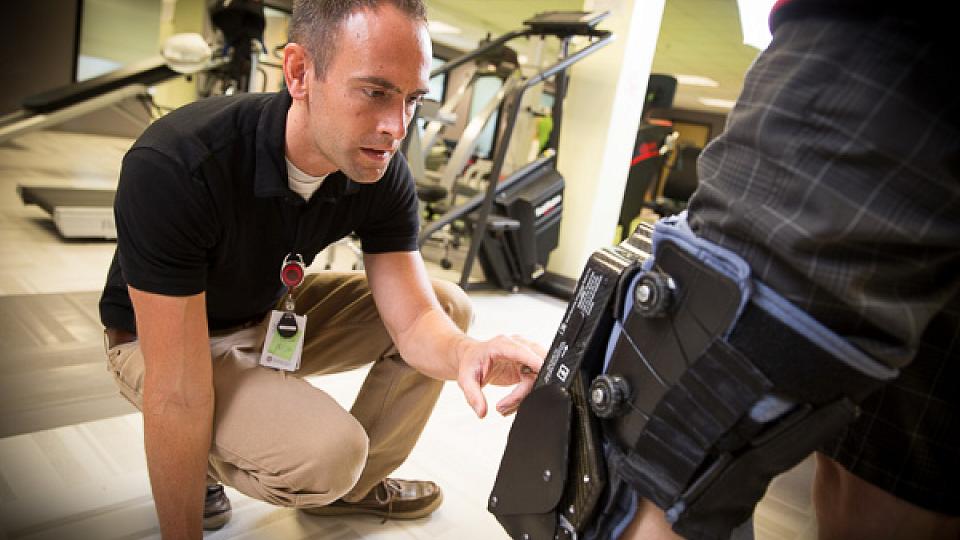![[media-entity-reference:media-alt]](/sites/g/files/zrelqx136/files/styles/billboard_tablet/public/media/images/2023/GettyImages-1202210411-swallow-throat.jpg?h=8441088e&itok=nRzQCxRq)
Five Questions and Answers About Swallowing Difficulties After a Stroke
![[media-entity-reference:media-alt]](/sites/g/files/zrelqx136/files/styles/billboard_desktop/public/media/images/2023/GettyImages-1202210411-swallow-throat.jpg?h=8441088e&itok=pBJF518N)
Five Questions and Answers About Swallowing Difficulties After a Stroke
Every year, more than 795,000 Americans have a stroke—and more than half of survivors develop swallowing difficulties. Left untreated, this serious medical condition called dysphagia can cause malnourishment, dehydration, and even pneumonia. The good news is dysphagia is highly treatable and most stroke patients can recover within a matter of weeks or months.
Here are some answers to common questions about post-stroke dysphagia that can help you get back to the joy of eating once again with friends and family.
1. I’m experiencing symptoms. Could this be dysphagia?
If you are experiencing any of these symptoms after a stroke, it’s time to get examined by your doctor:
- Coughing or choking when eating or drinking
- Regurgitating food or liquid, sometimes through the nose
- Swallowing food or liquid down the wrong tubes
- Sensations of “stuck” food in the throat
- Residual food or liquid in the mouth after swallowing
- Changes in vocal quality, typically wet and gurgling
- Drooling and inability to control saliva
- Coughing and throat clearing after eating and drinking
- Inability to coordinate breathing and swallowing
Dysphagia is not specific only to stroke patients. These symptoms are also associated with other medical conditions such as traumatic brain injuries, dementia, and Parkinson’s disease.
2. What should I expect in treatment?
After undergoing diagnostic tests, patients will be given individualized treatment plans that typically involve various medical specialists, including a speech-language pathologist (SLP).
Camille Stanley, MS, and Amber Udall, MS, of the Craig H. Neilsen Rehabilitation Hospital at University of Utah Health, treat stroke patients with traditional dysphagia exercises in tandem with Neuromuscular Electrical Stimulation called Ampcare. This non-invasive, FDA-approved treatment stimulates nerves that correspond to inactive or weakened swallowing muscles.
“Some of the main things I look for when working with stroke patients is the ability to control and transport food or liquid through the mouth as well as efficiently and safely transporting food or liquid through the throat (pharynx) to the esophagus,” Stanley says. “The goal is to help them return to their typical diet.”
Here are some common exercises that are often prescribed to patients.
- Shaker Exercise: While lying down on your back, tuck your chin and focus on your toes. Hold the position, lower, then repeat as directed by your provider.
- Effortful Swallow: In a seated or standing position, squeeze your throat muscles as hard as you can and swallow. Repeat these steps as directed by your provider.
Pro tip: Don’t be a slouch! When eating, always sit upright in a chair in a distraction-free environment.
3. What foods should I eat?
The road to recovery after a dysphagia diagnosis can be overwhelming, especially when it comes to diet. Fortunately, the International Dysphagia Diet Standardization Initiative provides a handy resource for patients who need a little help taking the guesswork out of the dysphagia diet. Udall advises patients to work with their sleep language pathologist (SLP) to know which diet consistency is best for them.
“Dysphagia cases are not one size fits all,” Udall says. “Individuals may have difficulty with either food, liquid, pills, or all of the above. The International Dysphagia Diet Standardization Initiative was created, in part, to combat ambiguity with diet plans that call for foods of various textures, modifications, and foods to avoid.”
4. How can I speed up my progress?
The key to recovery is consistency. Keep working with your SLP, who will measure your progress every step of the way. Patients are encouraged to put pen to paper and log their exercises during treatment and note any questions and concerns.
“Patients who don’t complete swallow exercises may not progress as quickly as those who are more diligent,” Stanley says. “Depending on the severity of dysphagia and their adherence to diet recommendations, patients may also have an increased risk of pulmonary decline, dehydration, or not meeting caloric needs.”
5. How can I feel less alone during recovery?
Coping with swallowing problems can feel overwhelming and isolating—especially while sitting at the dinner table with others who are effortlessly enjoying their food. Don’t hesitate to reach out to support groups for dysphagia patients and stroke survivors to talk it out among others who are sharing similar struggles.





